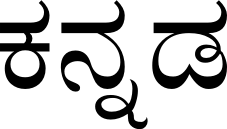Language/Kannada/Grammar/How-to-Use-Have
Hi Kannada learners! 😊
In this lesson, we will cover the use of "Have" in Kannada grammar. It is an important word to know, as it is used to express ownership, possession, and other meanings. By the end of this lesson, you will be able to use "Have" correctly in your sentences. Let's get started!
Basic Usage
In Kannada, "Have" can be translated as "ಹೊಂದಿರು" (hondiru). It is usually used as the main verb in a sentence to indicate possession or ownership. Here are some examples:
| Kannada | Pronunciation | English |
|---|---|---|
| ನನ್ನಲ್ಲಿ ಬುದ್ಧಿ ಇದೆ. | nannaLLi buddhi ide. | I have intelligence. |
| ರಾಜ್ಯದಲ್ಲಿ ತಂತ್ರಜ್ಞಾನ ಇದೆ. | rajyadalli tantrajnyana ide. | There is technology in the state. |
| ನಮ್ಮ ಕುಟುಂಬದಲ್ಲಿ ಬೆಳೆಯಿದೆ. | nam'ma kuTum'badalli beLeyide. | It is grown in our family. |
Note that "ಹೊಂದಿರು" (hondiru) is used in its various forms based on gender and tense. For example, “ಇದೆ” (ide) is used in the present tense for singular objects, whereas “ಇವೆ” (ive) is used for multiple objects. Similarly, masculine and feminine forms are used for gender differences.
Using "Have" in Different Contexts
"Have" is used in a variety of contexts in Kannada. Below are some examples of how to use it in different contexts.
Possession
"Have" is often used to indicate possession of an object or something. To use "Have" in a sentence, you can simply add the verb “ಹೊಂದಿರು” (hondiru) after the subject.
Example:
- Person 1: ನೀನು ಪುಸ್ತಕವನ್ನು ಹೊಂದಿದ್ದೀಯಾ? (neenu pustakavannu hondiddee yaa?) (Do you have the book?)
- Person 2: ಹೌದು, ಅದನ್ನು ನನ್ನಲ್ಲಿ ಹೊಂದಿದ್ದೇನೆ. (hauDu, adannu nannalli hondidde-ne.) (Yes, I have it.)
Relationships
In Kannada, "Have" is used to talk about relationships. For example, you can use "Have" to talk about your family members or friends.
Example:
- Person 1: ನೀವು ಗಂಡ ಯಾವನು? (neevu gaMDa yaavana?) (Who is your husband?)
- Person 2: ಸುಮಾರು ಒಂದು ವರ್ಷದವನು, ಅವನ ಹೆಸರು ಕುಮಾರ್. (sumaru ondu varshadavana, avana hesaru kumaar.) (He is around 1 year old, and his name is Kumar.)
Time Expressions
"Have" is also used to indicate actions that took place in the past. This is done by using the past tense of "Have".
Example:
- Person 1: ನೀನು ಹೊಂದಿದ್ದೆ ಏನು ಸಮಯದಲ್ಲಿ? (neenu hondidde Enu samayadalli?) (When did you have it?)
- Person 2: ಕೆಲವು ವಾರಗಳ ಹಿಂದೆ ಹೊಂದಿದ್ದೆ. (kelavu vaaragala hinde hondidde.) (I had it a few weeks ago.)
Actions
In Kannada, "Have" can also be used in the present continuous tense to express current actions.
Example:
- Person 1: ನೀನು ಏನು ಮಾಡುತ್ತಿದ್ದೀಯ? (neenu Enu maaduttiDe-e?) (What are you having? - referring to food or drink)
- Person 2: ನಾನು ನೀರು ಕುಡಿಯುತ್ತಿದ್ದೇನೆ. (naanu neeru kudiyutthiddhena.) (I am having water.)
Exceptions
In Kannada, there are a few instances when you don't use "Have" to indicate possession. These instances are mentioned below:
Possession with "-inda" Particles
In Kannada, you can indicate possession without using "Have" by adding the "-inda" particle to the noun.
Example:
- ನನ್ನ ಸೈಕಲ್ ಹಳೆಯದು. (nanna saikalf haLeayadu.) (My bicycle is old.)
Possession with Copulas
You can also indicate possession using copulas. For example, you can use "ಇದೆ" (ide) or "ಉಂದು" (undu) to indicate possession.
Example:
- ನಮ್ಮ ಹೊಸ ಮನೆ ಇದೆ. (nam'ma hosa mane ide.) (We have a new house.)
Conclusion
In this lesson, we discussed the different ways "Have" can be used in Kannada grammar. Now that you have a better understanding of its usage, try using it in your daily conversations. If you need additional help or want to practice more, you can join our Kannada community on Polyglot Club. You can also learn more about Kannada [ [Language/Kannada/Grammar|Grammar]]. Practice and enjoy learning Kannada! 😊
➡ If you have any questions, please ask them in the comments section below.
➡ Feel free to edit this wiki page if you think it can be improved. 😎
Videos
Class | How to correctly use Have Has Had in English (In KANNADA)
Related Lessons
- Negation
- Future Tense
- How to Use Be
- Pronouns
- Give your Opinion
- Nouns
- Questions
- Gender
- Conditional Mood
Sources
- Kannada - Wikipedia
- The Top 10 Kannada grammar Tutors Near Me (For all ages & levels)
- Kannada grammar - Wikipedia

